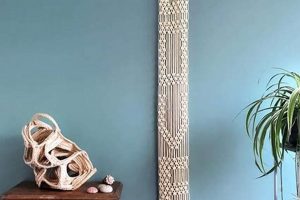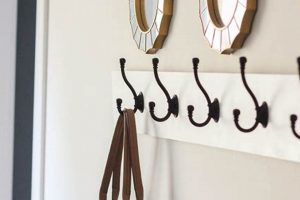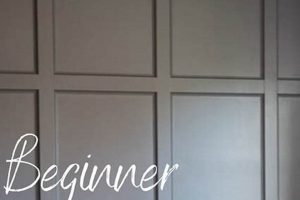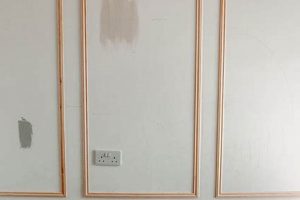The creation of sizable, personalized artwork for interior decoration through do-it-yourself methods is an increasingly popular trend. Examples include expansive canvas paintings produced at home, large-scale prints designed and output independently, or multi-panel installations assembled from individual handcrafted elements.
This practice offers several advantages. It provides a cost-effective means to enhance interior spaces with visually impactful pieces tailored to specific aesthetic preferences and spatial dimensions. Historically, individuals have always sought to personalize their environments, and this approach provides a modern, accessible avenue for self-expression and creative fulfillment.
The following sections will delve into various techniques and materials utilized in realizing these substantial artistic projects, exploring considerations for design, execution, and installation to achieve professional-looking results.
Techniques for Creating Expansive Decorative Pieces
The production of substantial, customized wall decor requires careful planning and execution. The following points address critical aspects to consider during the creation process.
Tip 1: Material Selection: Prioritize durable, lightweight substrates for ease of handling and installation. Canvas stretched over a wooden frame, large format paper mounted on board, or lightweight wood panels are suitable options. Consider archival quality materials to ensure longevity of the finished artwork.
Tip 2: Scale and Proportion: Accurately measure the intended display space and plan the artwork’s dimensions accordingly. Create a scaled mock-up to visualize the piece in situ. Disproportionately sized artwork can detract from the overall aesthetic of the room.
Tip 3: Design Conceptualization: Develop a clear design concept before commencing the physical creation. Sketch preliminary designs, consider color palettes, and experiment with different compositions. A well-defined plan minimizes errors and ensures a cohesive final product.
Tip 4: Surface Preparation: Properly prepare the chosen substrate. Sand wooden panels smooth, apply gesso to canvas to create a suitable painting surface, or ensure paper is free from creases and imperfections. Adequate preparation ensures optimal adhesion and a professional finish.
Tip 5: Execution Techniques: Employ appropriate techniques based on the selected medium. Practice brushstrokes, color mixing, and layering techniques on a smaller scale before applying them to the main artwork. Consistency in application contributes to a polished final result.
Tip 6: Sealing and Protection: Apply a protective sealant or varnish to safeguard the finished artwork from environmental factors such as dust, moisture, and UV light. This step is particularly important for pieces created with delicate materials or those intended for display in high-traffic areas.
Tip 7: Installation Considerations: Plan the installation method in advance. Utilize appropriate hanging hardware capable of supporting the artwork’s weight. Consider the wall’s material and structural integrity. Secure installation prevents accidental damage and ensures long-term stability.
These strategies offer means to produce impressive, self-made decorative elements, allowing for personalization and cost-effectiveness in interior design.
The subsequent segment will explore specific artistic styles and their suitability for these ambitious projects.
1. Scale
Scale is a foundational consideration in the creation of do-it-yourself large wall art, directly influencing both the visual impact and the practical feasibility of the project. The dimensions of the artwork must harmonize with the surrounding environment; a piece that is too small may appear insignificant, while one that is excessively large can overwhelm the space. A fundamental cause-and-effect relationship exists: The chosen scale dictates material requirements, the complexity of the design, and the effort required for execution and installation. For example, attempting a highly detailed painting on a canvas spanning several meters necessitates advanced artistic skill and meticulous planning, whereas a more abstract design can offer greater flexibility and ease of execution.
Understanding scale is crucial for several reasons. Firstly, it affects the perceived aesthetic value of the piece. An artwork appropriately scaled to its surroundings creates a sense of balance and visual harmony. Conversely, a mismatch in scale can detract from the overall appearance of the room. Secondly, scale influences the logistical challenges of the project. Larger works require more substantial materials, specialized tools, and a greater degree of physical effort. Consider the real-life example of creating a large mosaic panel: each tile’s size and placement must be meticulously planned to ensure the final image is clear and proportionate. Misjudging the scale of individual elements can result in a distorted or incoherent artwork.
In conclusion, scale is not merely a measurement but a critical design element in DIY large wall art. It dictates the aesthetic impact, the practical challenges, and the overall success of the project. Careful consideration of scale, through accurate measurements and scaled mock-ups, ensures a harmonious integration of the artwork into its intended environment. Addressing challenges associated with handling and installing large-scale pieces is essential for both the longevity and visual appeal of the final product, effectively linking individual components to the broader aesthetic theme.
2. Materials
The selection of materials is paramount in the creation of do-it-yourself large wall art, exerting a direct influence on both the aesthetic outcome and structural integrity of the finished piece. The size and intended display environment inherently constrain material choices; for instance, substantial canvases require robust stretcher bars to prevent warping, while artwork intended for moisture-prone areas necessitates water-resistant media and sealants. This cause-and-effect relationship underscores the critical role materials play in realizing the artist’s vision. The importance of appropriate material selection cannot be overstated, as substandard components can compromise the longevity and visual appeal of the artwork. Consider the real-life example of a large-scale mural painted on an exterior wall: using paints not formulated for outdoor use would result in premature fading and cracking, necessitating costly repairs or complete replacement.
Furthermore, the choice of materials significantly affects the practical aspects of creation and installation. Lightweight options, such as foam core or thin wood panels, are easier to handle and mount, particularly for solo artists or in spaces with limited structural support. Conversely, heavier materials like thick wood or metal may offer greater durability and a more premium aesthetic, but they also demand more robust mounting hardware and potentially professional installation. A practical application of this understanding lies in selecting archival-quality papers and inks for large-format prints to ensure colorfastness and resistance to degradation over time. This careful selection adds to the artwork’s value and extends its lifespan, avoiding the need for frequent replacements.
In summary, the judicious selection of materials forms the bedrock of successful DIY large wall art projects. It determines not only the visual characteristics but also the structural stability, ease of handling, and long-term durability of the artwork. Challenges often arise in balancing cost-effectiveness with quality and longevity; however, prioritizing appropriate materials based on the artwork’s size, intended environment, and artistic style ultimately ensures a worthwhile and enduring final product. The quality of materials is closely related to the overall design and the techniques applied, further emphasizing the need for careful material selection.
3. Technique
Technique represents a critical element in the execution of do-it-yourself large wall art, mediating the translation of conceptual designs into tangible visual realities. The scale of these projects inherently amplifies the impact of both skillful and unskilled execution; imperfections that might be negligible in smaller works become prominently visible in expansive formats. A cause-and-effect relationship exists: appropriate technique yields aesthetically pleasing and structurally sound results, while inadequate technique leads to visual flaws, material waste, and potential instability. The importance of mastering or adapting techniques to the large format is vital. A real-life example involves creating a large-scale canvas painting. Without proper layering and blending techniques, the colors can appear uneven and the overall image lacks depth, detracting from the intended artistic effect.
The choice of technique dictates the type of materials used and the level of expertise required. A simple geometric mural, for instance, might be executed with masking tape and spray paint, demanding precision but relatively little artistic skill. Conversely, a complex, photorealistic image reproduced on a large scale necessitates advanced painting or printing techniques, extensive knowledge of color theory, and meticulous attention to detail. For instance, applying a decoupage technique to a large surface requires a careful consideration of adhesive properties, paper weight, and sealing methods to prevent bubbling, warping, or peeling over time. Each approach provides different pathways for realization, demanding tailored preparation and execution. These practical applications underscore the significance of technique in achieving the intended aesthetic outcome.
In conclusion, technique is a cornerstone of successful DIY large wall art, affecting not only the visual appearance but also the longevity and structural integrity of the piece. Challenges arise in balancing artistic ambition with technical capabilities; however, prioritizing careful planning, practice, and a thorough understanding of the chosen technique ultimately ensures a rewarding and visually impressive final product. Therefore, careful design coupled with skilled and appropriate application ensures the visual coherence and durability of the finished art piece.
4. Design
Design serves as the foundational blueprint for all do-it-yourself large wall art projects. It dictates the aesthetic direction, influences material choices, and guides the execution process, ultimately determining the visual impact and cohesive integration of the artwork within its intended environment.
- Conceptualization and Planning
The initial stage involves generating ideas, establishing a theme, and developing a preliminary sketch or digital rendering. This includes defining the color palette, composition, and overall style. For example, a minimalist abstract design might involve geometric shapes and a limited color scheme, while a landscape scene would require careful consideration of perspective and tonal values. This planning phase minimizes errors and ensures alignment with the intended aesthetic.
- Scale and Proportion Determination
Accurately determining the dimensions of the artwork relative to the intended display space is crucial. A scaled mock-up, either physical or digital, allows for visualization of the piece within its surroundings. Inappropriate proportions can diminish the impact of the artwork and disrupt the visual harmony of the room. This facet extends beyond size to include how elements are proportioned within the artwork itself.
- Material Selection and Integration
The design concept dictates the appropriate materials to be utilized. A design featuring intricate textures might necessitate the use of mixed media, while a clean, modern design might lend itself to a digital print on canvas. The design must also consider how materials will be integrated to achieve the desired effect. Failing to account for the interplay of materials during the design stage can lead to structural issues or aesthetic inconsistencies.
- Execution Strategy and Technique Adaptation
The design must be feasible within the artist’s skillset and available resources. Complex designs might require specialized techniques or equipment. Adapting established techniques to the large format is often necessary, as the challenges inherent in working on a larger scale differ significantly from smaller-scale projects. For example, a design incorporating fluid art techniques might require a modified application method to ensure even coverage and prevent unwanted pooling.
Ultimately, a well-conceived design provides a roadmap for the successful creation of do-it-yourself large wall art. Each of the facets described above contributes to a cohesive and visually impactful final product, ensuring that the artwork complements and enhances its intended environment. Thoughtful design directly leads to a professional-looking and aesthetically pleasing finished piece.
5. Installation
Installation represents a critical, often underestimated, phase in the do-it-yourself large wall art process. It transitions the completed artwork from a creative endeavor into an integrated component of the intended environment. Proper installation ensures the aesthetic impact, structural security, and long-term preservation of the piece. Neglecting this phase can negate the effort invested in design and creation.
- Weight Assessment and Support Systems
The weight of the artwork dictates the necessary support system. Incorrectly assessing the weight and using inadequate hardware can result in structural failure, causing damage to the artwork and potentially the surrounding wall. For example, a large canvas stretched on a heavy wooden frame requires sturdy wall anchors capable of supporting the load, whereas a lightweight printed fabric panel may only require adhesive strips. Selection of appropriate hangers and wall fasteners must align with the art’s weight to ensure stability.
- Wall Material Compatibility
Different wall materials (drywall, plaster, brick, concrete) require specific installation techniques and hardware. Attempting to install a heavy artwork on drywall using only nails will inevitably lead to failure. Anchors designed for drywall provide a secure hold, while brick and concrete require specialized drill bits and masonry anchors. Understanding wall composition is essential to selecting compatible installation methods. Real-life considerations of the wall’s structural capacity are as important as aesthetic decisions.
- Leveling and Alignment Techniques
Precise leveling and alignment are essential for visual appeal. A slightly askew artwork can detract significantly from the overall aesthetic of a room. Tools such as levels, laser levels, and measuring tapes ensure accurate placement. For multi-panel installations, precise alignment is paramount to maintaining the integrity of the design. Consistent horizontal and vertical positioning significantly elevates the professional quality of the installed art.
- Safety Considerations
Safety must be prioritized during installation. Utilizing appropriate safety gear (gloves, eye protection) and following safe lifting practices is crucial to prevent injury. For large or heavy artworks, enlisting assistance is advisable. Ensuring the installation area is clear of obstacles and that electrical wiring is avoided is also paramount. Integrating these preventative measures minimizes the risks associated with handling heavy items and potentially hazardous tools.
These considerations underscore the importance of meticulous planning and execution during the installation phase of do-it-yourself large wall art. Properly addressing weight assessment, wall material compatibility, leveling/alignment, and safety ensures the artwork is not only visually appealing but also securely and safely integrated into its intended environment. The final impression of any artwork hinges on a successful and secure installation.
Frequently Asked Questions About DIY Large Wall Art
The following questions and answers address common inquiries and challenges encountered in the creation and installation of self-made, sizable decorative wall pieces.
Question 1: What is the optimal size for artwork intended for a large wall, and how is this determined?
The optimal size depends on the dimensions of the wall and the surrounding space. A general guideline is that the artwork should occupy approximately two-thirds to three-quarters of the available wall space. Precise measurement and a scaled mock-up are recommended to ensure visual harmony.
Question 2: Which materials are most suitable for creating lightweight, large-format artwork?
Lightweight options include stretched canvas, foam core board, thin wood panels, and printed fabric. These materials offer a balance of durability and ease of handling, facilitating installation without excessive weight strain on the wall structure.
Question 3: How can one ensure a professional-looking finish when painting large-scale canvases at home?
Achieving a professional finish requires meticulous surface preparation, the use of high-quality paints, and employing proper layering and blending techniques. Consistent brushstrokes and attention to detail are also essential. Applying a final varnish or sealant protects the artwork and enhances its visual appeal.
Question 4: What are the best methods for securely mounting large artwork on various wall types (drywall, plaster, brick)?
Drywall requires the use of anchors designed to distribute weight and prevent pull-through. Plaster walls often necessitate specialized plaster screws or anchors. Brick walls demand masonry drill bits and appropriate masonry anchors. Selecting the correct hardware based on wall type is crucial for a secure and stable installation.
Question 5: How does one prevent warping or sagging in large canvases or wood panels?
To prevent warping, canvases should be stretched tightly over robust stretcher bars. Wood panels should be adequately sealed and, if necessary, reinforced with a backing frame. Storing the artwork in a climate-controlled environment also minimizes the risk of warping due to humidity or temperature fluctuations.
Question 6: What are some cost-effective strategies for creating impactful, large-scale wall art on a limited budget?
Cost-effective strategies include utilizing readily available materials such as repurposed wood or fabric, employing simple design techniques like geometric patterns or abstract designs, and creating multi-panel installations from smaller, more affordable components.
These answers offer practical guidance for navigating the challenges of DIY large wall art, promoting successful project outcomes. The following sections delve into style inspirations for these unique decorative endeavors.
The subsequent segment will explore design inspirations tailored for these ambitious creative projects.
DIY Large Wall Art
The preceding exposition has explored the multifaceted considerations inherent in the creation of “diy large wall art.” From the fundamental importance of scale and material selection to the critical role of technique, design, and installation, each facet contributes directly to the aesthetic impact, structural integrity, and long-term viability of these substantial decorative pieces. Successfully navigating these interrelated aspects enables the realization of personalized, visually compelling artwork tailored to specific spatial requirements and aesthetic preferences.
The pursuit of “diy large wall art” offers a compelling avenue for self-expression and interior personalization. It requires a commitment to meticulous planning, skillful execution, and a thorough understanding of the inherent challenges. While the endeavor may demand significant effort, the potential rewards are considerable: the creation of enduring, visually impactful art that enhances the aesthetic character of the environment and provides a tangible manifestation of individual creativity. Continued exploration and refinement of these techniques will undoubtedly contribute to the evolution and accessibility of this increasingly popular art form.







